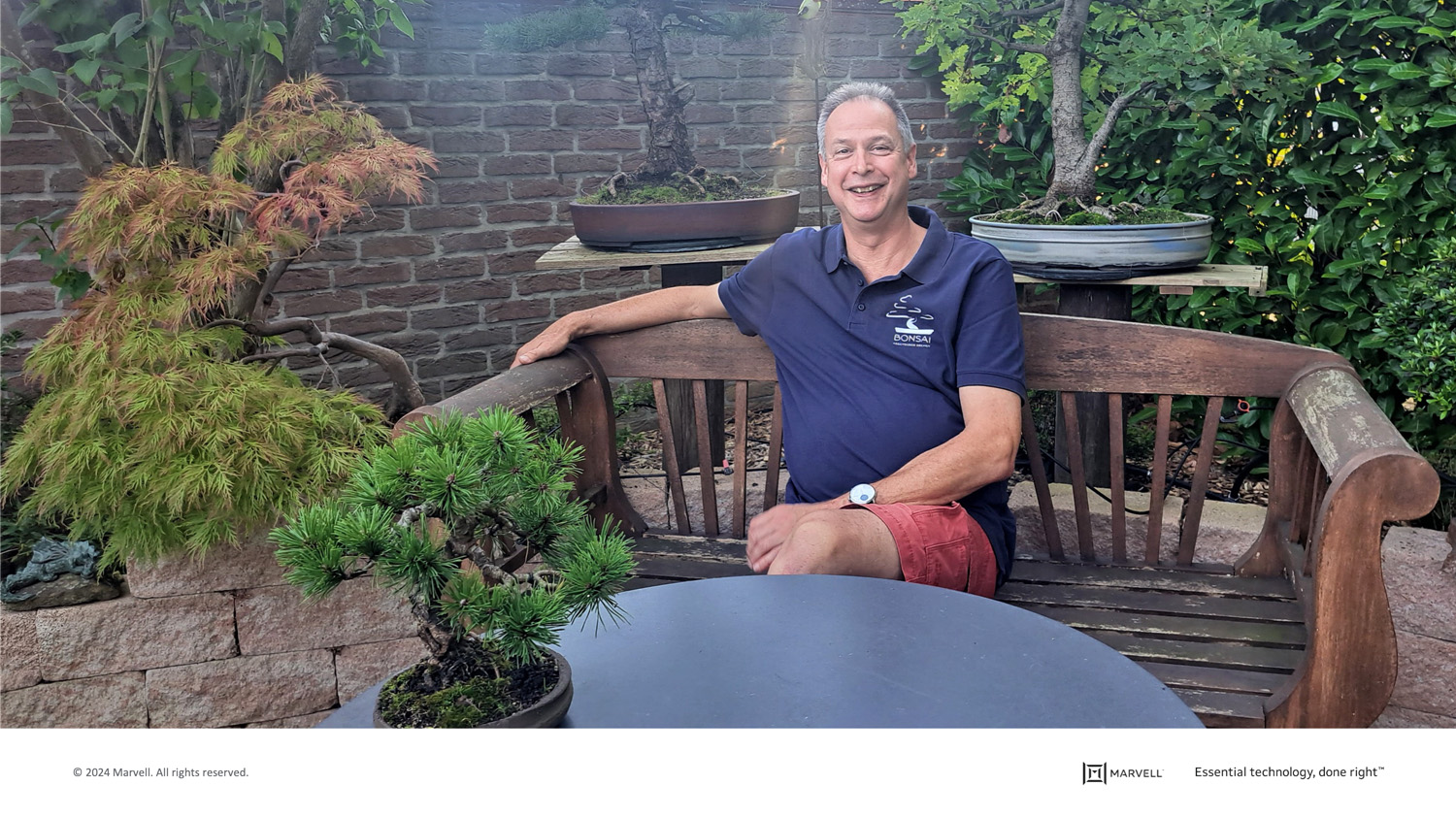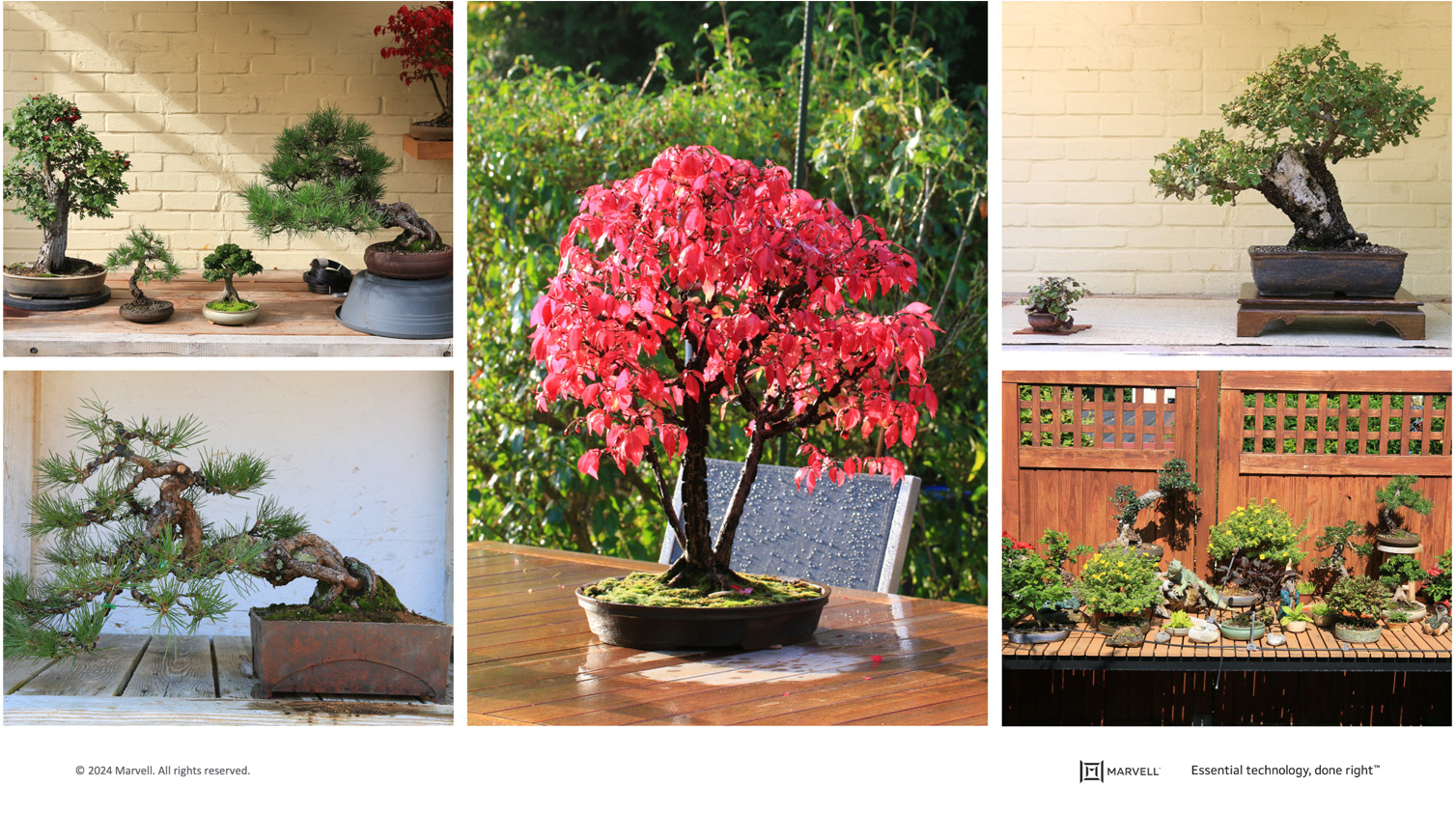- PRODUCTS
- COMPANY
- SUPPORT
- PRODUCTS
- BY TYPE
- BY MARKET
Compute
Networking
- Automotive
- Coherent DSP
- Data Center Switches
- DCI Optical Modules
- Enterprise Switches
- Ethernet Controllers
- Ethernet PHYs
- Linear Driver
- PAM DSP
- PCIe Retimers
- Transimpedance Amplifiers
Storage
Custom
- COMPANY
Our Company
Media
Contact
- SUPPORT
What Makes Marvell – A “Labor of Love” as a Bonsai Tree Master
 At Marvell, navigating a dynamic work environment demands precision and attention to detail. Our team members often channel these same skills into their personal passions and hobbies as well. Meet Thomas Pfeffer, Marvell's EMEA Distribution Manager, whose passion lies in cultivating bonsai trees – a "labor of love" that intertwines both nature and art. Join us as we explore Thomas's unique journey and discover how these miniature marvels also bring a touch of serenity and accomplishment to his professional life.
At Marvell, navigating a dynamic work environment demands precision and attention to detail. Our team members often channel these same skills into their personal passions and hobbies as well. Meet Thomas Pfeffer, Marvell's EMEA Distribution Manager, whose passion lies in cultivating bonsai trees – a "labor of love" that intertwines both nature and art. Join us as we explore Thomas's unique journey and discover how these miniature marvels also bring a touch of serenity and accomplishment to his professional life.
Thomas has up to 110 bonsai trees in his 750-square foot garden in northern Germany and goes to up to a dozen shows a year to share his passion. A cross between horticulture and art, bonsai trees may be tiny, but they have an immense impact on the masters who care for them. Says Thomas, “Over the last years, my attitude toward bonsai changed from a ‘beautiful little tree’ to an absolute balance to my professional life. It also goes beyond that. I now walk through nature differently than before and bonsai has even influenced the furnishings and design of my house and rooms.”
Years of styling, wiring, watering, repotting, and pruning separate amateur bonsai trainers from masters, like Thomas. It took him 16 years to get certified to teach. He says about the training, “Teachers want to see your development and how your trees have developed over time. You have to learn a lot of styles – some that are not for beginners. And you must have patience.”
On Zoom calls with Marvell colleagues, Thomas occasionally brings in different trees into his background to share with them. Says Caroline Abreu, one of Thomas’s colleagues on the calls, “He told us about becoming a bonsai master and the smile on his face was priceless. We have a really cohesive team anyway, but we really enjoy those few moments outside of a work discussion to share in a colleague’s accomplishments.”
Owners often pass on their trees to someone else over generations as bonsais can live for hundreds of years. Inherently fragile, they must be monitored every day for signs of deadly insect infestation or disease. As Thomas explains, “To keep a tree small and healthy, you need to repot the tree and cut the roots every few years. I use a special soil that the water goes right through to avoid root rot. Granular soil will support the growing of the roots, and the better the plant does.
Bonsai trees were originally developed in China where they symbolize building nature in a small area. They then became very popular in Japan where the different styles are developed over the years, like Chokkan (Formal Upright); Fukinagashi (Windswept); Kengai (Cascade). “Bonsai” literally means “planted in a container”.
How did Thomas stumble upon this passion? “I was always interested. I got one as a birthday present, then a second. I found some classes then just started learning, first as a designer then to get the certification as a bonsai teacher.
He says all you need is an eye for detail and an imagination to grow bonsais, adding that you can get as creative with bonsais as you want to be. So, where does he take his passion from here?
“I have been working in the IT industry for more than 30 years. I would like to demonstrate this with terms such as speed, restlessness, and pressure to succeed. Today, I'm working on a tree not just because it's fun, but also to create a vibrant work/life balance in my life.”
Here is a collage of some of Thomas’ masterpieces.

Bottom left: Master class project - Japanese black pine (Pinus thunbergia) tree, almost 95 years old.
Center image: Red leaves of Euonymus alatus in Aug/Sept.
Upper right: Kermes oak (Quercus coccifera) tree with companion plant, almost 150 years old.
Tags: What Makes Marvell
Recent Posts
Archives
Categories
- 5G (12)
- AI (21)
- Automotive (26)
- Cloud (9)
- Coherent DSP (5)
- Company News (101)
- Custom Silicon Solutions (2)
- Data Center (44)
- Data Processing Units (22)
- Enterprise (25)
- ESG (6)
- Ethernet Adapters and Controllers (12)
- Ethernet PHYs (4)
- Ethernet Switching (36)
- Fibre Channel (10)
- Marvell Government Solutions (2)
- Networking (33)
- Optical Modules (12)
- Security (6)
- Server Connectivity (23)
- SSD Controllers (6)
- Storage (22)
- Storage Accelerators (2)
- What Makes Marvell (32)
Copyright © 2024 Marvell, All rights reserved.
- Terms of Use
- Privacy Policy
- Contact

